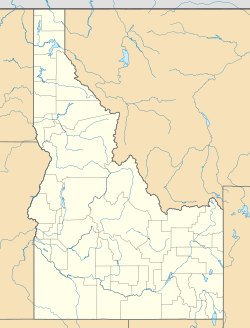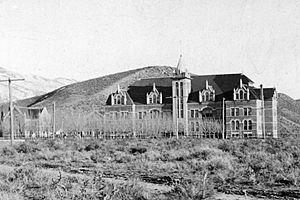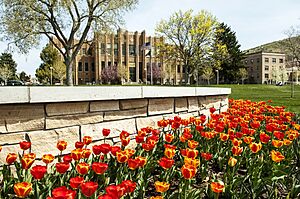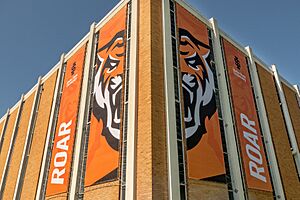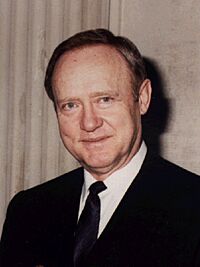Idaho State University facts for kids
 |
|
|
Former names
|
Academy of Idaho (1901–1915) Idaho Technical Institute (1915–1927) University of Idaho—Southern Branch (1927–1947) Idaho State College (1947–1963) |
|---|---|
| Motto | Latin: Veritas Vos Liberabit |
|
Motto in English
|
"The truth will set you free" |
| Type | Public research university |
| Established | March 11, 1901 |
|
Parent institution
|
Idaho State Board of Education |
| Accreditation | NWCCU |
|
Academic affiliations
|
|
| Endowment | $75 million (2021) |
| President | Robert W. Wagner |
|
Academic staff
|
826 (Fall 2019) |
| Students | 12,614 (Fall 2023) |
| Undergraduates | 10,406 (Fall 2023) |
| Postgraduates | 2,208 (Fall 2023) |
| Location |
,
,
United States
42°51′40″N 112°26′02″W / 42.861°N 112.434°W |
| Campus | Small city, 1,000 acres (4.0 km2) |
| Other campuses | |
| Newspaper | Idaho State Journal |
| Colors | Orange and black |
| Nickname | Bengals |
|
Sporting affiliations
|
NCAA Division I FCS - Big Sky |
| Mascot | Benny the Bengal |
 |
|
Idaho State University (ISU) is a public research university located in Pocatello, Idaho, United States. It was started in 1901 as the Academy of Idaho. Today, ISU offers more than 250 different study programs. You can find its main campus in Pocatello, with other locations in Meridian, Idaho Falls, and Twin Falls.
ISU is known for its research activities. Over 12,000 students attend Idaho State. About 57 percent of the students are female and 43 percent are male. There is one teacher for every 13 students, which means students can get lots of help. About 58 percent of students take classes full-time.
Contents
University History
How ISU Started
On March 11, 1901, the Academy of Idaho was officially created. This happened after Governor Frank W. Hunt signed a special bill. The city of Pocatello helped by donating land for the school. The Academy of Idaho opened its doors on September 22, 1902. John W. Faris was the first leader of the school. By 1910, almost 300 students were attending. The school bought more land to help with its growth.
Name Changes Over Time
The Academy of Idaho changed its name to Idaho Technical Institute in 1915. After World War I, many more students joined the school. Enrollment grew to over 1,000 students. In the early 1920s, the school chose the Bengal as its mascot. Ralph Hutchinson, a football coach, helped make the tiger the mascot. He also pushed for orange and black to be the school's official colors. Hutchinson had gone to Princeton, another university with a tiger mascot.
In 1927, the school changed its name again to the University of Idaho–Southern Branch. It was a two-year school at this time. During World War II, Idaho State was one of many colleges that helped train students for the Navy. This program helped students become officers.
In March 1947, the school became a four-year college. It was officially named Idaho State College. Carl W. McIntosh became the first president of Idaho State College. He was one of the youngest college presidents in the country. In December 1948, Idaho State College was approved to give out four-year degrees. By 1949, 2,000 students were enrolled.
On July 1, 1963, the college changed its name for the last time to Idaho State University. This new name showed that it was now a full four-year public university.
Growth and Leadership
Idaho State University continued to grow over the years. It added more students and more programs. Richard L. Bowen was president from 1985 to 2005. This time is remembered as a period of great growth for the university. During his time, projects like the Stephens Performing Arts Center were built.
Arthur C. Vailas became president on July 1, 2006. He retired in August 2017. Kevin D. Satterlee then became the new president.
Interesting Places at ISU
The main campus in Pocatello is about 4,550 feet above sea level.
Research and Innovation Centers
Idaho State works with the Idaho National Laboratory and other universities. Together, they created the Center for Advanced Energy Studies in 2007. This center helps with energy research.
In 2011, ISU bought a large building. This building became The ISU Research and Innovation in Science and Engineering Complex (RISE). It was a place for advanced research. Later, this building was changed into the William M. and Karin A. Eames Advanced Technical Education and Innovations Complex. It now hosts many programs from the College of Technology.
Health and Arts Facilities
The Kasiska Division of Health Sciences was reorganized in 2011. This helps students learn about health in different ways. It also helps the community through ISU's 18 clinics.
In 1998, Idaho State University received a large gift of $10 million. This money helped start the building of the Stephens Performing Arts Center. This center cost $34 million and was built with help from many private donors.
What Students Can Study
| USNWR National University | 392-434 |
|---|---|
| Washington Monthly National University | 178 |
Career Path Internships
The Career Path Internship (CPI) program started in 2011. It helps students get real work experience while they are still in school. All CPI internships are paid jobs. They are connected to what the student is studying or their career goals. In 2016, the CPI program offered about 1,000 internships.
Special Programs
ISU offers two advanced nursing programs. One is a Doctor of Philosophy (Ph.D.) degree in nursing. This program started in summer 2013 and is the only one of its kind in Idaho.
ISU is also a top place for nuclear training. The Energy Systems Technology and Education Center (ESTEC) at ISU helps coordinate nuclear energy education. It is a Northwest Regional Center of Excellence for Nuclear Education and Training. This means it helps train technicians in nine different states.
The university has a doctoral experimental psychology program. This program is the only one of its kind in Idaho. It started in fall 2011. A new geosciences doctoral program also began in August 2013.
The Center for Sports Concussion at ISU opened in 2009. It teaches people about how to identify and manage concussions. This helps athletes in eastern Idaho stay safe.
The university gives out The Teaching Literature Book Award. This award is for the best book about teaching literature at a college level.
University Research
At the CORE, ISU teachers and students do research on many topics. This includes understanding autism and how sleep affects habits.
In 2012, ISU researchers found clues about how to stop a chemical in the brain. This chemical can lead to memory problems and strokes. This research helps in the fight against memory diseases.
In 2013, a team of ISU researchers found something interesting about fish. They discovered that fish show behaviors similar to autism after being in water with certain medicines. This study was shared around the world.
Health Sciences at ISU
Idaho State's Kasiska Division of Health Sciences (KDHS) has many health-related programs. The KDHS Family Medicine Residency Program is the only medical education program sponsored by an Idaho university.
The ISU Health Center helps students with their medical needs. It gets over 10,000 visits from students each year. The costs for visits are lower than other health services.
In 2009, Idaho State opened a new campus in Meridian, Idaho. This campus offers health professional programs. In 2011, the Delta Dental Clinic opened there. It helps low-income patients and trains dentists. The clinic has 17 treatment rooms.
The ISU Meridian Health Science Center planned to open a new anatomy and physiology lab in 2014. This lab uses advanced virtual tools to help students learn about the human body.
Arts Programs
In fall 2013, ISU started offering a bachelor's degree in dance. This is the only dance major of its kind in Idaho's university system. With this new degree, ISU's School of Performing Arts now has majors in music, theater, and dance.
Student Life
| Race and ethnicity | Total | ||
|---|---|---|---|
| White | 71% |
|
|
| Hispanic | 15% |
|
|
| Two or more races | 4% |
|
|
| Unknown | 3% |
|
|
| American Indian/Alaska Native | 2% |
|
|
| International student | 2% |
|
|
| Asian | 1% |
|
|
| Black | 1% |
|
|
| Economic diversity | |||
| Low-income | 40% |
|
|
| Affluent | 60% |
|
|
Student Government and Activities
Students at ISU have their own government called the Associated Students of Idaho State University (ASISU). Each year, students elect a president and vice-president. These leaders help manage many activities funded by student fees. The ASISU Senate is a group of 20 students who decide how the ASISU budget is spent.
The Student Activities Board plans fun events on campus. These include concerts, movie nights, and homecoming activities. They also organize events related to sports and other student life activities.
Campus Facilities for Students
Reed Gym has many places for recreation. It has a climbing wall, a swimming pool, and tennis courts. The Pond Student Union has a movie theater, a billiard room, and a bowling alley. It also hosts many student club events. Fine arts shows are often held at the performing arts theater.
ISU has over 140 student groups. These groups are for different interests like professional studies, academics, culture, service, and social activities. Cultural groups often host big "Cultural Nights" celebrations. There are also four fraternity and sorority chapters at the university.
Student Media and Resources
Students can read The Bengal, which is a weekly newspaper run by students. KISU-FM (91.1) is the student radio station. It broadcasts from the Pond Student Union. It plays alternative music, NPR programs, and covers ISU women's sports. In 2010, KISU-FM started a monthly talk show called FIRST MONDAY: Idaho State University Forum. This show shares information about the university and local interests.
The Pond Student Union, also called the SUB, is a central place for the university community. It has three floors. Inside, you can find the campus bookstore, student government offices, and the Outdoor Adventure Center. There's also a craft shop, a credit union, a bowling alley, a movie theater, and many rooms for meetings and events.
The Rendezvous Complex is a large building built in 2007. It has 50 classrooms of different sizes. It also has a big computer center and meeting rooms. There are 80 student apartments with 301 beds in this complex. It also has the Mind's Eye Art Gallery.
The Cooperative Wilderness Handicapped Outdoor Group (CW HOG) helps people of all abilities enjoy outdoor activities. It started in 1981 and is run by dedicated volunteers.
In August 2010, Reed Gym opened a new addition called the Student Recreation Center. This added nearly 100,000 square feet of recreational space. It includes more weight and exercise areas, classrooms, and viewing areas for the indoor tennis courts. There are also racquetball courts, another gym, a track, a climbing wall, a swimming pool, and spinning rooms.
Student Housing
Idaho State University offers several places for students to live. These include residence halls and apartment complexes.
Residence halls include Rendezvous Hall, Turner Hall, Nichols Hall, Owen Hall, and Redfield Hall. On-campus apartments include Bengal Studios, McIntosh Manor, Pulling Courts, Ridge Crest Townhomes, Schubert Heights, University Courts, and West Campus Apartments.
Students with children can live in McIntosh Manor, Pulling Courts, and Ridge Crest Townhouses. These homes are in the Pocatello/Chubbuck School District. Local schools include Washington Elementary, Franklin Middle School, and Century High School.
Sports at ISU
The Idaho State University Bengals compete in the Big Sky Conference. They are part of the NCAA Division I FCS. ISU won the NCAA Division I-AA national championship in football in 1981. They also won NCAA national championships in boxing as Idaho State College in 1953 and 1957.
In recent years, ISU has done well in track and field. The women's track and field team won their first outdoor Big Sky conference title in 2007.
Sports Facilities
Home football games are played at the ICCU Dome. This stadium can hold 12,000 people for football games. It is the oldest enclosed stadium on a college campus in the United States. The ICCU Dome also hosts indoor track and field events.
Davis Field is where ISU's track and soccer teams play. It was built in 1936. It was first called the "Spud Bowl." After the ICCU Dome was built, it became home to the track and field program. Its name was changed to honor Bud Davis, a former ISU president. In 1998, women's soccer was added, and Davis Field became their home.
ISU started a softball program in 1976, but it stopped in 1983. In 2007, the program was brought back. In 2011, Idaho State built Miller Ranch Stadium, which is the home of Bengal softball. The Big Sky Conference added softball in 2013, and ISU won the first regular season Big Sky title.
The ISU cross country team meets on the Centennial Course. This course is located east of the main campus. The Bengals first used the course in 2002.
Reed Gym is the updated home for Idaho State women's basketball, tennis, and volleyball. It can seat 3,040 people. The building was updated in 2002. It is also used by the men's basketball team when the ICCU Dome is not available.
In the spring of 2011, ISU's athletic department received full certification from the National Collegiate Athletic Association (NCAA). This means their sports programs meet high standards. To meet NCAA rules, ISU built a new women's softball complex. They also increased funding and scholarships for women's sports.
In 2011, ISU received a new basketball court and football field. The basketball court is called Idaho Central Credit Union Court at Holt Arena. Reed Gym's court is also called Idaho Central Credit Union Court.
In 2013, the ISU Athletics department finished third in the Big Sky Conference President's Cup. This was their highest finish ever. Idaho State also placed first in the conference for overall academics. A record 183 student-athletes were named to Big Sky All-Academic teams that year.
Famous People from ISU
Sports Stars
- Jared Allen – NFL defensive end, known for leading the league in sacks.
- Ron Boone – a former professional basketball player and current announcer for the Utah Jazz.
- Wally Buono – a very successful coach in the Canadian Football League.
- Stacy Dragila – won a gold medal in pole vault at the 2000 Olympics.
- Merril Hoge – a former football player and sports commentator.
- Marvin Lewis – a well-known NFL head coach.
- Ed Sanders – won a gold medal in boxing at the 1952 Olympics.
Other Notable Alumni
- Don Aslett – an author and founder of a cleaning company.
- Shay Carl Butler – a popular YouTube content creator.
- James A. McClure – served as a U.S. Senator for many years.
- William Petersen – an actor, famous for his role in CSI: Las Vegas.
- Antonio Taguba – a retired Major General in the United States Army.
- Roger Williams – a famous pianist.
See also
 In Spanish: Universidad Estatal de Idaho para niños
In Spanish: Universidad Estatal de Idaho para niños
- Eli M. Oboler Library


